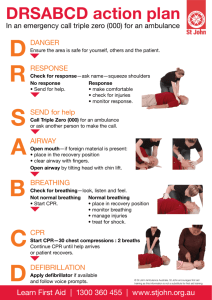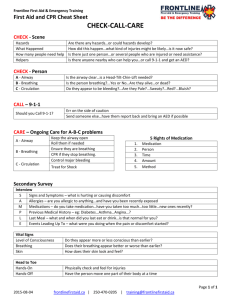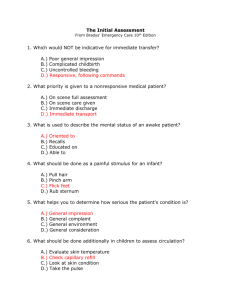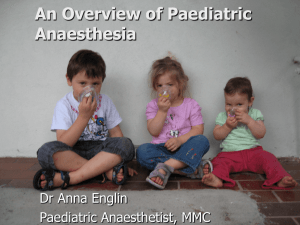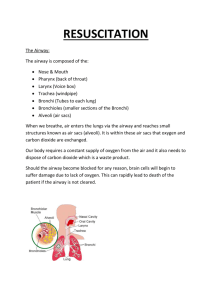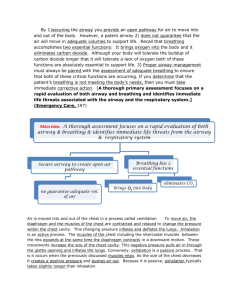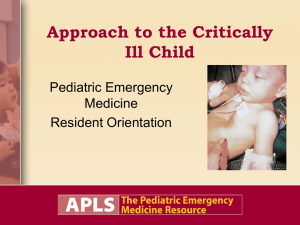MS Word File
advertisement
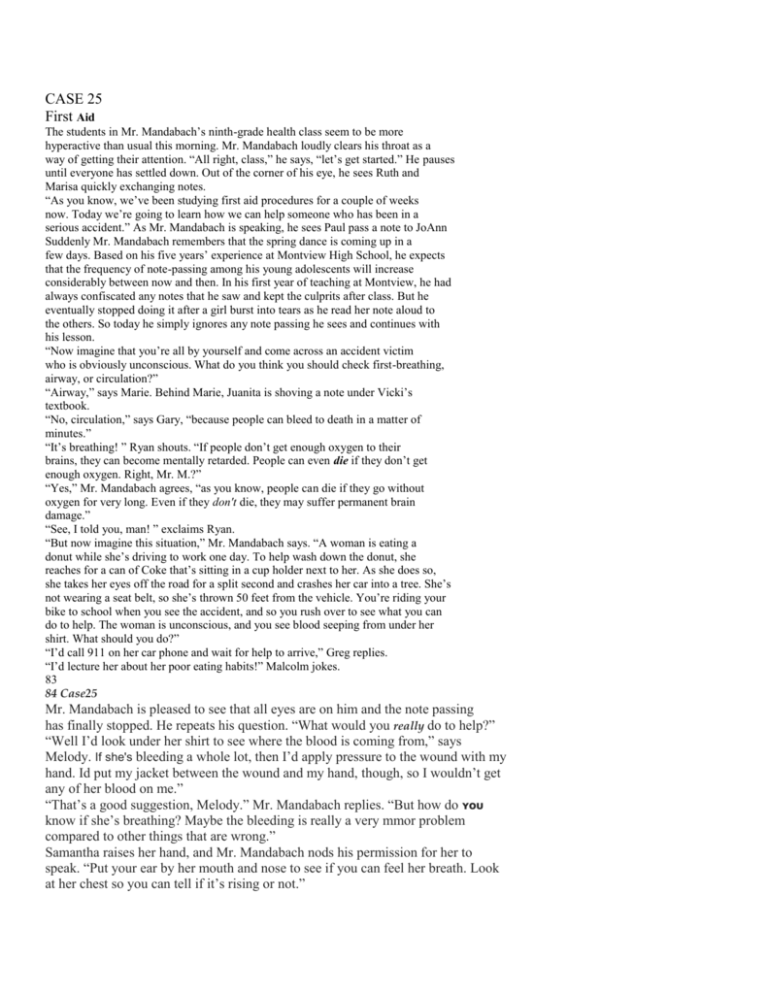
CASE 25 First Aid The students in Mr. Mandabach’s ninth-grade health class seem to be more hyperactive than usual this morning. Mr. Mandabach loudly clears his throat as a way of getting their attention. “All right, class,” he says, “let’s get started.” He pauses until everyone has settled down. Out of the corner of his eye, he sees Ruth and Marisa quickly exchanging notes. “As you know, we’ve been studying first aid procedures for a couple of weeks now. Today we’re going to learn how we can help someone who has been in a serious accident.” As Mr. Mandabach is speaking, he sees Paul pass a note to JoAnn Suddenly Mr. Mandabach remembers that the spring dance is coming up in a few days. Based on his five years’ experience at Montview High School, he expects that the frequency of note-passing among his young adolescents will increase considerably between now and then. In his first year of teaching at Montview, he had always confiscated any notes that he saw and kept the culprits after class. But he eventually stopped doing it after a girl burst into tears as he read her note aloud to the others. So today he simply ignores any note passing he sees and continues with his lesson. “Now imagine that you’re all by yourself and come across an accident victim who is obviously unconscious. What do you think you should check first-breathing, airway, or circulation?” “Airway,” says Marie. Behind Marie, Juanita is shoving a note under Vicki’s textbook. “No, circulation,” says Gary, “because people can bleed to death in a matter of minutes.” “It’s breathing! ” Ryan shouts. “If people don’t get enough oxygen to their brains, they can become mentally retarded. People can even die if they don’t get enough oxygen. Right, Mr. M.?” “Yes,” Mr. Mandabach agrees, “as you know, people can die if they go without oxygen for very long. Even if they don't die, they may suffer permanent brain damage.” “See, I told you, man! ” exclaims Ryan. “But now imagine this situation,” Mr. Mandabach says. “A woman is eating a donut while she’s driving to work one day. To help wash down the donut, she reaches for a can of Coke that’s sitting in a cup holder next to her. As she does so, she takes her eyes off the road for a split second and crashes her car into a tree. She’s not wearing a seat belt, so she’s thrown 50 feet from the vehicle. You’re riding your bike to school when you see the accident, and so you rush over to see what you can do to help. The woman is unconscious, and you see blood seeping from under her shirt. What should you do?” “I’d call 911 on her car phone and wait for help to arrive,” Greg replies. “I’d lecture her about her poor eating habits!” Malcolm jokes. 83 84 Case25 Mr. Mandabach is pleased to see that all eyes are on him and the note passing has finally stopped. He repeats his question. “What would you really do to help?” “Well I’d look under her shirt to see where the blood is coming from,” says Melody. If she's bleeding a whole lot, then I’d apply pressure to the wound with my hand. Id put my jacket between the wound and my hand, though, so I wouldn’t get any of her blood on me.” “That’s a good suggestion, Melody.” Mr. Mandabach replies. “But how do YOU know if she’s breathing? Maybe the bleeding is really a very mmor problem compared to other things that are wrong.” Samantha raises her hand, and Mr. Mandabach nods his permission for her to speak. “Put your ear by her mouth and nose to see if you can feel her breath. Look at her chest so you can tell if it’s rising or not.” “Aha! ” Mr. Mandabach responds. “So what do you do if you see that she’s not breathing’? Ihink about what we did with the mannequins last week when the person from the Red Cross came to visit.” “Do CPR! ” yells most of the class. “Wait a minute,” says Marie. “How do we know she’s not choking on the donut? Maybe it’s blocking her airway.” Mr Mandabach looks around the room for reactions to Marie’s observation, but there arenone. “This time we bow the person was eating prior to the accident. But most of the time, we aren’t so lucky. We may not have a clue about what’s going on when we first see an injured person. We should always check an unconscious person’s airway first. Why do you think we should do this?” “Because if we did CPR and her airway was blocked, we wouldn’t be doing her any good,” Gary replies. “Right! You wouldn’t be able to get any oxygen to her lungs no matter what you did. But now say that her airway isn’t blocked. What would you do then?” “You’d give her CPR,” Malcolm answers. “Right again,” says Mr. Mandabach. “So...airway, breathing, and then what?” “Circulation,” Greg says. “Good,” says Mr. Mandabach. “We treat someone’s bleeding...we deal with circulation problems...only after we’ve already made sure that he or she is breathing.” “Mr. M.?” asks Ahsa. “What if we’re all stressed out and can’t remember which one comes first? “You have a point, Alisa,” Mr. Mandabach responds. “But fortunately someone from the Red Cross came up with a very simple way to remember the order of first aid responses: ‘A, B, C,’ for airway, breathing, circulation.” “Thats pretty clever the way you used ‘A, B, C,’ M.” Mr. M" Blake tells him. “Isn’t it, though? Okay, let’s consider another situation.... First Aid 85 NOTE: Every year, Mr. Mandabach made sure that his students became certified by the Red Cross in both First Aid and CPR. Possible questions for “First Aid”: 1. 2. 3. 4. What would you do if students were passing notes during a lesson? How does Mr. Mandabach finally focus his students’ attention on the topic of first aid? Higher-level questtons require learners to analyze, apply, or elaborate on new information. Lower-level questions require learners to report isolated facts in relatively the same fashion in which they learned the material. What types of questions does Mr. Mandabach ask? Retrieval cues are hints that help learners recall information from their long-term memory. On what two occasions does Mr. Mandabach give his students retrieval cues to help them remember things they’ve already learned? What evidence do we see that students are constructing new responses to Mr. Mandabach S questions rather than simply retrieving them from memory? Howfrequently a!oes Mr. Mandabach give his students feedback regarding the things they are saying? From Piaget’s perspective, at what stage of cognitive development must students be in order to understand first aid procedures? From Vygotsky‘s perspective, the Zone of Proximal Development (ZPD) is the range of tasks that a student can peqorm only with the assistance of a more capable individual. . How does Mr. Mandabach teach within his students’ ZPD?
